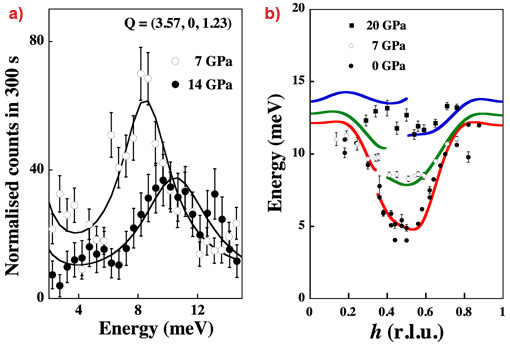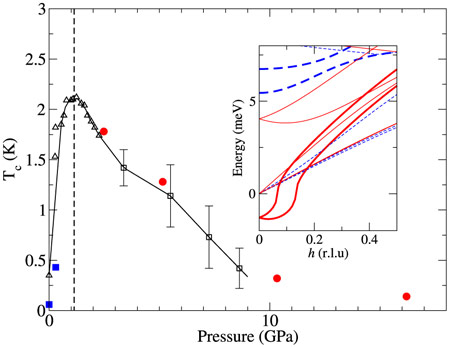- Home
- News
- Spotlight on Science
- The role of electron-phonon...
The role of electron-phonon coupling in understanding the phase diagram of uranium
06-03-2012
Scientists have investigated the mechanisms that governs the interplay between the charge density wave and superconductivity in uranium using inelastic X-ray scattering (IXS) at the ESRF as well as ab initio calculations.
Share
Competition between different ground states is a central issue in condensed-matter physics. Besides the relationship between superconductivity and magnetism in cuprates, iron pnictides, and heavy fermions, the influence of a charge density wave (CDW) on superconductivity has attracted a lot of interest. Inelastic X-ray scattering (IXS) and ab initio calculations have been employed to investigate the mechanisms that govern such an interplay in uranium.
Uranium crystallises at room temperature in an unusual orthorhombic structure (α-U phase) unique for an element at ambient pressure. A phase transition to a CDW state occurs below 43 K [1] and this behaviour has been ascribed to nesting of certain features of the Fermi surface [2]. The CDW state (called α1-U), to a first approximation, may be considered as a doubling of the a-axis of the unit cell. Under pressure, the CDW disappears at around 1.5 GPa while superconductivity exhibits a maximum transition temperature (Tc) of about 2 K.
The key aspect, which stabilises the low-symmetry α-U structure, is the narrow band containing about three 5f electrons at the Fermi level. Modelling the 5f electrons accordingly, the unusual phonon spectrum of α-U was reproduced only in 2008 by ab initio calculations [3], almost 30 years after its experimental determination [4]. A prediction of this calculation is that under pressure the energy of the soft phonon mode Σ4 in the [100] direction increases, until the anomaly disappears near 20 GPa.
In order to validate this theoretical prediction, an IXS experiment was performed at the beamline ID28 on a single-crystal sample placed in a diamond anvil cell. Figure 1a shows IXS spectra taken around the key position in reciprocal space for two pressures. This establishes the hardening of the Σ4 mode as pressure is increased. Figure 1b shows the experimental (points) and theoretical (lines) dispersion along the [100] direction for three pressures.
The excellent agreement between theory and experiment lead to a further investigation of the phase diagram. Theoretical studies revealed that the Fermi surface, and consequently the nesting conditions, evolves only very little with pressure. In contrast, the electron-phonon (e-ph) coupling was found to be very sensitive to the wave-vector, reaching a maximum where the soft mode occurs. This maximum is, however, rapidly suppressed when pressure increases. Thus, e-ph coupling is the crucial ingredient for the formation and the disappearance of the α1-U (CDW) state. Fermi-surface nesting is indeed present, but although necessary, it is not the unique ingredient.
The fascinating interplay between the CDW and superconductivity under pressure was also investigated theoretically. For phonon-mediated superconductivity, the knowledge of the e-ph coupling allows the determination of Tc. By calculation it was shows that e-ph coupling increases in the CDW phase until the structure is unstable just above 1 GPa (see inset of Figure 2). In contrast, at higher pressures, the e-ph coupling decreases in the α phase, as discussed above. Thus the dome shape of the superconducting region is explained by the pressure dependence of e-ph coupling in concomitance with the respective stability of the α1-U and α-U phases. Figure 2 shows the good agreement between the measured and calculated superconducting transition temperatures as a function of pressure.
The phonon measurement in uranium confirms a theoretical prediction about the disappearance of the soft mode under pressure. Further investigation of the mechanism at play emphasises that the momentum and pressure dependence of the e-ph coupling plays the central role in determining the complex phase diagram of uranium including the CDW and superconductivity, whereas the Fermi-surface nesting is independent of pressure.
Principal publication and authors
S. Raymond (a), J. Bouchet (b), G.H. Lander (c), M. Le Tacon (d,e), G. Garbarino (d), M. Hoesch (d), J.-P. Rueff (f,g), M. Krisch (d), J.C. Lashley (h), R.K. Schulze (h), R.C. Albers (h), Physical Review Letters 107, 136401 (2011).
(a) CEA, DSM, INAC, Grenoble (France)
(b) CEA, DAM, DIF, Arpajon (France)
(c) Institute for Transuranium Elements, Karlsruhe (Germany)
(d) ESRF
(e) Max-Planck-Institut für Festkörperforschung, Stuttgart (Germany)
(f) Synchrotron SOLEIL, Gif-sur-Yvette (France)
(g) Laboratoire de Chimie Physique, Paris (France)
(h) Los Alamos National Laboratory, New Mexico (USA)
References
[1] G.H. Lander et al., Advances in Physics 43, 1 (1994) and references therein.
[2] L. Fast et al., Phys. Rev. Lett. 81, 2978 (1998).
[3] J. Bouchet, Phys. Rev. B 77, 024113 (2008).
[4] W.P. Crummett et al., Phys. Rev. B 19, 6028 (1979).
Top image: Cross section of the Fermi-surface topology for the alpha-U structure calculated at a) ambient pressure and b) 20 GPa. The different colours correspond to different sheets of the Fermi surface.





